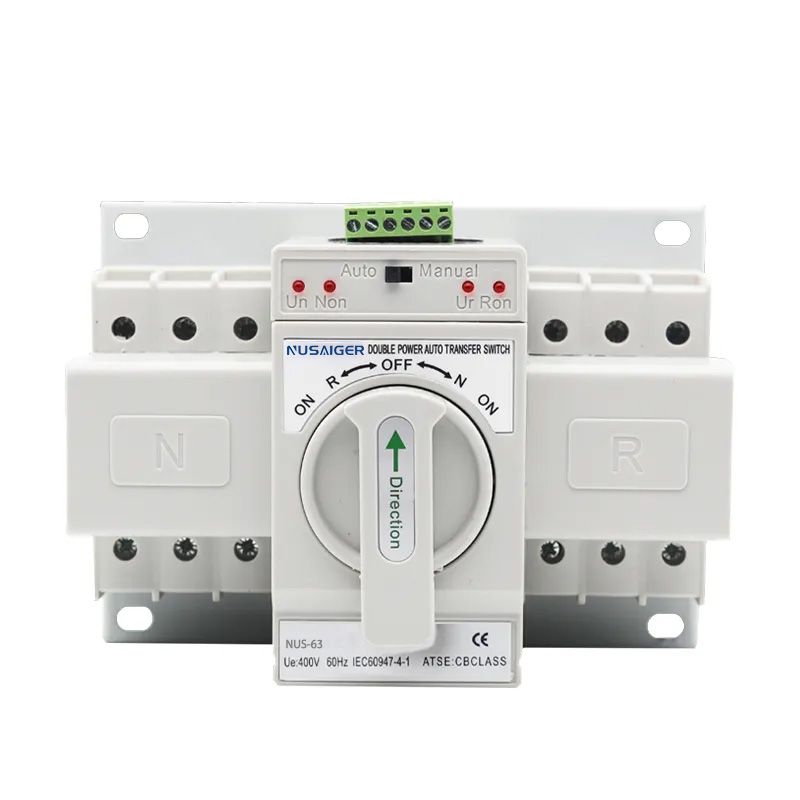Automatic Transfer Switch (ATS) Explained: Types, Working Principles, and Installation Guide
An Automatic Transfer Switch (ATS) is the core component of a dual power supply system. It monitors two independent power sources and ensures that critical loads are supplied with electricity even if one source fails. ATS is widely used in hospitals, data centers, industrial plants, and commercial buildings to maintain uninterrupted operations.
1. Introduction: Why ATS Is Critical
Imagine a hospital during a surgery, or a data center running critical servers—any power interruption can cause serious consequences. The ATS provides a seamless transfer between primary and backup sources, minimizing downtime and preventing damage to sensitive equipment.
2. What Is an Automatic Transfer Switch?
An ATS is a device that automatically detects the failure of the primary power source and transfers the electrical load to the backup source. Once the primary power is restored, the ATS can transfer the load back, either automatically or manually, depending on system configuration.
3. Types of ATS
There are several types of ATS, each designed for specific applications:
- Open Transition (Break-Before-Make): The load disconnects from the primary source before connecting to the backup, causing a brief interruption.
- Closed Transition (Make-Before-Break): Provides uninterrupted power by momentarily paralleling the sources during transfer.
- Static Transfer Switch (STS): Electronic switches that transfer power in milliseconds, ideal for sensitive loads.
- Manual Transfer Switch (MTS): Operator-controlled, less common in critical applications.
4. Working Principles of ATS
The ATS operates using sensors, relays, and control logic:
- Monitoring: Continuous measurement of voltage, frequency, and phase angle.
- Decision: Detects abnormal conditions such as voltage drop, surge, or complete outage.
- Transfer: Switches the load to the backup source within milliseconds to seconds.
- Return: When the primary source stabilizes, the ATS can transfer back automatically or remain on backup, depending on settings.
5. ATS Components
- Power Contacts: Handle the load current safely.
- Control Logic: Microprocessor or relay-based controllers.
- Indicators: LED or digital displays showing source status and load position.
- Communication Modules: For remote monitoring via SCADA, IoT, or building management systems.
6. ATS Installation Guide
Proper installation ensures safety and reliable operation. Key steps include:
- Verify the load rating and select the appropriate ATS size.
- Install near the main distribution board to minimize cable length.
- Ensure proper grounding to prevent electrical hazards.
- Follow manufacturer wiring diagrams precisely.
- Test the ATS under simulated power failure conditions.
7. Industry Applications
7.1 Hospitals
ATS ensures operating rooms, ICU, and critical medical equipment remain powered during outages.
7.2 Data Centers
Maintains server uptime by switching between grid and generator or dual grid feeds.
7.3 Industrial Plants
Protects production lines, preventing costly stoppages and machinery damage.
7.4 Commercial Buildings
Maintains elevators, security systems, and lighting during power interruptions.
8. ATS vs UPS vs Generator
Understanding differences helps design reliable systems:
- UPS: Provides instant battery backup for short-term outages.
- Generator: Long-term backup source, typically starts within seconds.
- ATS: Automatically switches between primary and backup sources.
Combination of UPS + Generator + ATS ensures continuous, clean, and reliable power for critical loads.
9. Troubleshooting Common ATS Issues
- ATS fails to transfer → Check control logic and input voltage.
- Delay in switching → Inspect relays and mechanical contacts.
- Frequent false transfers → Check for voltage fluctuations or grounding issues.
- Overheating → Verify load rating and ventilation.
10. Case Study: Commercial Data Center
A commercial data center in Singapore installed dual utility feeds with ATS and a generator backup. After several tests, the ATS successfully switched loads in 150 ms during simulated outages, preventing downtime and SLA penalties.
11. Maintenance Best Practices
- Monthly functional test under simulated power failure
- Check for loose connections and torque terminals
- Clean contacts and inspect for corrosion
- Update firmware for smart ATS controllers
- Perform thermal imaging annually to detect hotspots
12. ATS Selection Guide
When selecting ATS, consider:
- Load current rating
- Number of phases (single-phase vs three-phase)
- Type of transfer (open vs closed vs static)
- Integration with monitoring systems
- Compliance with standards (IEC 60947-6-1, UL 1008, GB/T 14048.11)
13. Emerging Trends in ATS Technology
- IoT-enabled monitoring and predictive maintenance
- Smart ATS with AI-based load prediction
- Integration with renewable energy and microgrids
- Compact and modular designs for industrial and commercial use
14. FAQ
- Q1: How fast does an ATS switch?
A: Typically 50–300 ms; static transfer switches are faster (4–10 ms). - Q2: Can ATS work with solar panels?
A: Yes, hybrid systems allow seamless switching between solar, grid, and generator. - Q3: Do small offices need ATS?
A: Optional, but recommended for critical loads like IT servers or security systems. - Q4: How often should ATS be tested?
A: Monthly functional tests and annual maintenance checks. - Q5: Can ATS handle high inrush loads?
A: Select ATS rated for motor loads or large inductive loads.
Conclusion
An Automatic Transfer Switch (ATS) is the backbone of dual power supply systems. Understanding its types, working principles, installation, and maintenance ensures reliable power for critical operations. With advances in smart technology and IoT integration, ATS is becoming more intelligent, efficient, and indispensable for modern infrastructure.



